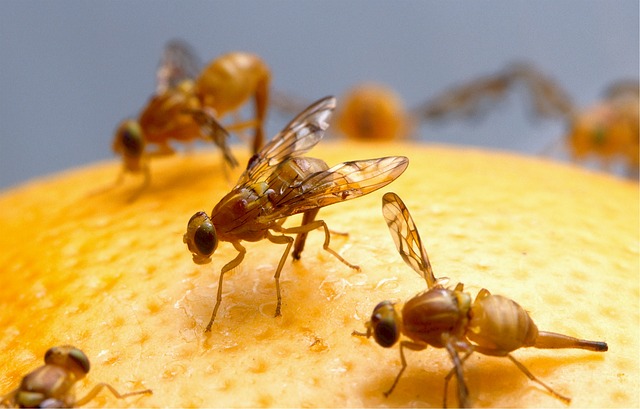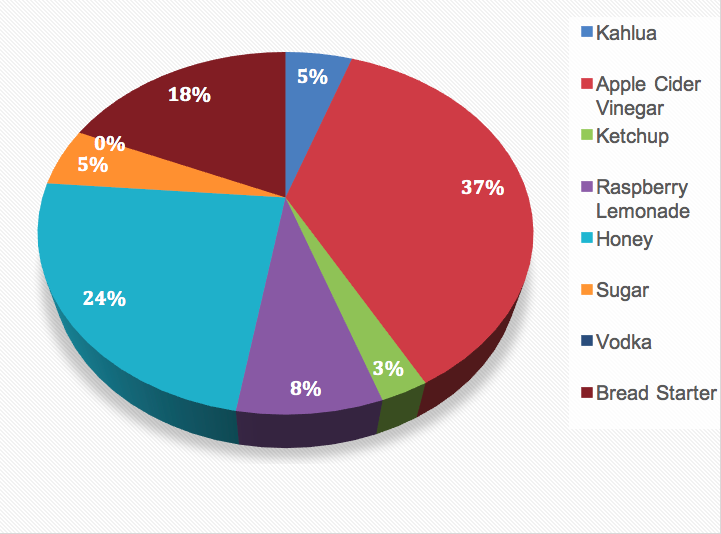By William Ahern
BACKGROUND
This project was designed to develop and produce a low cost, environmentally friendly, and effective product to eliminate fruit flies. The inspiration to do this project was obtained from watching family members constantly trying to swat these tiny insects that appeared out of nowhere, most commonly in the kitchen but also all over the house. My research was very helpful in figuring out the best household substances to use to eliminate fruit flies. There have been many ideas about how to best eliminate fruit flies, but few are effective. Two of the least effective substances for attracting them are vodka and Kahlua. I did some research and found out that this is because fruit flies are not attracted to fermented sugars in high volumes which is what alcohol is made of.
Fruit flies, also called pomace flies or vinegar flies in English, and Drosophila melanogaster in Latin, are a common and destructive household insect. There are over 1500 species of fruit fly and they have a life span ranging from 14 to 41 days (World of Biology, 2006). Fruit flies can be found in their largest quantity during the spring season. Females can lay up to 2000 eggs in their lifetime, and fruit flies have no predators which makes it easier for them to grow in large numbers (Mediterranean fruit fly, 2011). Fruit flies and their larvae feed on deciduous, subtropical, and tropical fruits, as well as on some vegetables. Fruit flies are attracted to ripe fruits because they contain acetic acid, yeast that gives them protein, and sugars that give them energy (World of Biology, 2006). Every time that a fruit or vegetable is eaten away at by a fruit fly, the fruit starts to rot. Fruit flies eat only certain parts of a fruit, so when they are finished, the rest of the fruit is completely wasted. This is a problem for humans, as fruit flies are destructive to household fruits and vegetables and also to fruit and vegetable crops. Rotting fruit is also a source of bacteria that is then spread by fruit flies.
There have been efforts made to eliminate the fruit fly problem. However these methods involve the use of insecticides, which are both expensive and can be harmful to the environment (N. K. Joshi et al., 2014). If an effective product that eliminated fruit flies that was both low cost and safe to the environment was invented it could be used in households and then eventually by farmers for use on their crops. In the future I hope to scale up my research and make it available to fruit farmers in my region, the Annapolis Valley in Nova Scotia, because apple growing and viticulture are a central part of our local economy.
Table 1. Comparative cost of fruit fly eliminator.
PURPOSE
This experimental set up was decided on to help establish what ingredients would prove most efficient at attracting and eliminating fruit flies (see Figure 1). Experiments were carried out in which eight common, inexpensive, environmentally harmless substances were used to see which would catch the most fruit flies.
Figure 1. Experimental setup.
The ingredients that were chosen were: ketchup because of its vegetable content, apple sauce because of its fruit content, honey because of the viscus sugar, raspberry lemonade because of its fructose and artificial flavoring content, Kahlua and vodka because of their fermented sugar, bread starter because of its yeast content, and apple cider vinegar because of its acetic acid content. Each bottle was labeled according to the substance that would be placed within it. Using a digital scale, 10g of the substance that was being tested and 30g of water were put into a small metal bowl and mixed vigorously until well combined. Using a funnel, the mixtures were poured into their bottles. Once the bottles with the various substances in them were set up, they were placed on a counter in a straight line so that they all got the same amount of light and were all kept at the same temperature. A kitchen compost pail was placed on either side of the row of bottles so that lots of fruit flies would be attracted to this space.
Each day for one week, the bottles were shaken sixteen times to make sure that the substance and the water were well combined. Every two days, observations were made about the smell and look of the substances in each bottle. Also, every two days, the temperature was recorded using the digital thermometer. Photographs were taken periodically throughout the course of the experiment. After seven days, the bottles were strained one at a time onto a large white plate and, using a magnifying glass, the number of fruit flies from each bottle was counted and then marked down on a chart on a sheet of paper.
Once this experiment was complete, a second experiment was conducted to re-test the two substances that attracted the most fruit flies—apple cider vinegar and honey—and to determine whether they might work successfully together. Using the same format as the previous experiment, a bottle with a honey and water mixture, a bottle with an apple cider vinegar and water mixture, and a bottle with the two substances combined were set on a counter for another seven days. Again, observations were made, and the number of fruit flies caught in each bottle was counted.
RESULTS
The purpose of this experiment was to determine which household substance would attract and eliminate the most fruit flies. The results demonstrated that apple cider vinegar was the most effective substance in catching fruit flies. In the first experiment, apple cider vinegar caught fourteen fruit flies, and in the second experiment, apple cider vinegar also caught fourteen fruit flies. The second most effective substance was honey. In experiment one, honey gathered nine fruit flies, and in experiment two, honey gathered zero fruit flies. In experiment number two, the two most successful substances from experiment two, the honey and the apple cider vinegar were also combined in an attempt to make the most successful mixture to eliminate fruit fly. The combination of apple cider vinegar and the honey managed to attract seventeen fruit flies, a result greater than either the apple cider vinegar or the honey individually. Figures 2 and 3 show the number of fruit flies caught by each substance tested in the experiments.
Figure 2. Number of Fruit Flies Caught by Each Substance in Experiment #1.
Figure 3. Number of Fruit Flies Caught by Each Substance in Experiment #2.
CONCLUSIONS
From this project, we have learned that a safe and inexpensive method of effectively eliminating fruit flies is available. The challenge now is to figure out how to make the product available in large quantities to farmers in agricultural communities. With the help of my Fruit Fly Eliminator the fruit fly problem can be stopped.
ACKNOWLEDGEMENTS
I would like to thank Mrs. Marilyn Curry, Librarian at King’s Edgehill School, who helped me find books for my project. My science teacher at King’s Edgehill School, Mrs. Michelle Belliveau, made sure that I stayed on track, and my mom took pictures of me working on my experiment and helped me format my tables and graphs.
REFERENCES
Apple cider vinegar. (2017, November 20). Heinz Canada. http://www.heinzvinegar.com/products-apple-cider-vinegar.aspx.
Borror, D. J., Delong, D.M., & Triplehorn, C.A. (1976). An introduction to the study of insects. New York: Holt, Rinehart and Winston.
Fedako, D., & Goff, E. (2017, November 22). Compost pedallers pebsite. Retrieved from https://compostpedallers.com.
Joshi, N.K, Biddinger, D.J, Demchak, K, Deppen, A. (2014). First report of Zaprionus indianus (Diptera: Drosophilidae) in commercial fruits and vegetables in Pennsylvania. J Insect Sci. 14, 259.
Mediterranean fruit fly. (2011). In Environmental encyclopedia. Retrieved from https://school.eb.com/levels/high/article/vinegar-fly/75423.
Mound, L. (2007). Insect. London: Eyewitness Books.
Philip, G. L. (2017, October 10). Fruit fly Drosophila melanogaster. In Science in context (Biology).
Piel, P. L. (2017, October 10). Christiane Nüsslein-Volhard. In Encyclopedia britannica (High School edition). Retrieved from https://school.eb.com/levels/high/article/Christiane- N%C3%BCsslein-Volhard/2479.
Ross, E. S. (2017, October 10). Vinegar fly. In Encyclopedia Britannica (High School edition). Retrieved from https://school.eb.com/levels/high/article/vinegar-fly/75423.
Tam, G. (2018, January 28). Life cycle of a fruit fly. Retrieved from https://cthanitcul15.wordpress.com/category/background/.
World of Biology. (2006, April 03). Online school resource.
About the Author
I am a Grade 8 student at King’s Edgehill School from Wolfville, Nova Scotia. When I am not developing new products for science fair, I enjoy playing basketball, soccer, and badminton. I play the organ and the piano, and I am currently working toward my Grade 10 RCM exam. This fall I joined my school’s school debate team and I am representing my province at the Junior Debating Nationals in Calgary this spring. I am excited about going to university and I am hoping to find a career that combines my interests in business, science, and law. I was inspired to invent my fruit fly eliminator by watching family members constantly swatting the fruit flies that appeared out of nowhere in our house every spring. This project has helped me create a solution to the problem of fruit flies at home. In the future I hope to scale up my research and make my product available to commercial fruit and vegetables growers as a safe alternative to insecticides. For all the students thinking about a project, I would say that it is important to start early, to feel passionate about your project, and to realize that it is an excellent educational experience.






